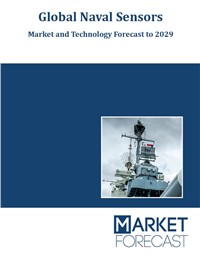Detection systems, integrated onto Naval Platforms, are used to detect both system as well as environmental changes associated with the platform. Information about the perimeter is used in order to devise strategic plans for naval operations. While the data procured for system functionality is used by technology innovators to monitor the operation and maintenance aspects of the product.
Growth in munition technology, as well as anti-ship/anti-submarine warfare systems, is one of the factors that boost the growth dynamics of the market. Sensors with enhanced sensitivity are now being devised to detect the movements of the adversaries. These components serve as the interface between the detection system and the environment. They are integrated onto the surface of technologies like RADAR, SONAR, LIDAR, and EW systems to optimize the combat abilities of a vessel. Amongst these sub-sets, SONAR systems account for roughly 21% of the product-based segment. ASW and underwater acoustic sensing capabilities associated with SONAR are some of the key factors that promote its growth.
RADAR systems account for the second-largest market segment. According to the product life cycle, both RADAR and SONAR account for mature market segments. RADAR systems make use of EM waves in order to transmit/receive information. EM waves tend to portray reduced efficiency when it comes to scenarios based on phase change. Therefore, technologies like Acoustic sensing and MAD (Magnetic Analogue Detection) are used for underwater detection by platforms like warships and logistical vessels.
On taking an overall perspective, the current Global Naval sensors Market accounts for a market value of roughly USD 5 billion as of 2020. The Global pandemic is one of the key factors that has created a shift in market trends. The CAGR for the market is anticipated to be 5% during the forecast period (2021-2029). Regions like China account for a maximum market value owing to its ongoing fleet procurement programs. The planning is to invest heavily in the development and procurement of naval armament in order to enhance its combat abilities. China’s strained relationships with the US and India as well as disputes like the South China Sea necessitate the requirement for a strong naval force.
The defense budget typically accounts for about 1-3% of the GDP. Countries surrounded by water bodies invest heavily in strengthening their naval defenses. Although, landlocked countries serve as a key restraint for this market. Moreover, the defense budget allocation for countries has decreased due to the negative multiplier effect since the inception of COVID-19. Countries all across the globe experience or expect military budget cuts due to the pandemic. The decrease in employment and per capita spending hereby accounts for a reduced naval contribution to the GDP. This in turn affects the future budget allocation. The defense budget for a nation is poised to be directly proportional to the naval spending amongst countries surrounded by water bodies.
On the contrary, growth in naval threats promotes the market expansion of this sector. Additionally, the waterways serve as a useful medium in terms of trade owing to the reduced cost of transportation. Therefore, countries have been investing in docks that could potentially facilitate connectivity. This in turn would reduce the logistical costs associated with the transportation of naval armaments and combatants across all platforms.
The report is aimed at
- A comprehensive analysis based on the drivers, restraints, and challenges for this market has been discussed within this report.
- The growth in technology and its impact on the upcoming trends associated with this market have been covered.
- The high growth segments within this market have been studied thoroughly.
- The potential growth segments and emerging markets have been covered.
- The opportunities provided by this market have been discussed on a country level.
- A competitive mapping across the market segmentation has been provided.
- The key players of this sector and the strategies employed by them have been covered.
- PEST and Porter’s five forces are used to understand the strategic mapping across several geographic spreads.
- A positive and a negative scenario analysis has been provided based on some growth criteria.
- A forecast analysis has been performed up to the year 2029.
- An analysis for the EXIM Data has been performed on a country level.
Segmentation covered in this report
By Region
- North America
- EU
- APAC
- ME
- RoW
By Platform
- Surface Warship
- Submarine
- Unmanned System
- Munition
- Others
By Product
- RADAR
- SONAR
- LIDAR
- Magnetometer
- IR sensors
- Seismic Sensors
- Hyperspectral Imaging
By Application
- Intelligence & Reconnaissance
- Communication & Navigation
- Combat Operations
- Electronic Warfare
- Target Recognition
- Command and Control
- Surveillance & Monitoring
By Country
- United States
- China
- Russia
- India
- South Korea
- France
- Italy
- United Kingdom
- Germany
- Israel
Reasons to buy this report
- The potential players of this market can use this report to understand the market dynamics associated with this sector.
- The Industry professionals can use this report to study expansion opportunities.
- Educational Institutions can use this report for secondary research.
- DODs can use this report to study the high growth markets.
- Financial investors can use this report while structuring funding programs to understand the potential high-growth markets market segments.
- Potential players can use this report to study the competitive mapping across this sector
Who is this report for?
- Technology Innovators: Can use this report to study the change in market trends and the impacts of upcoming technologies on the shift in dynamics.
- Raw Material Manufacturers: Can use this report to study the demand and supply margins associated with the EXIM data.
- OEMs: Can use this report to study the opportunity analysis on a country level.




